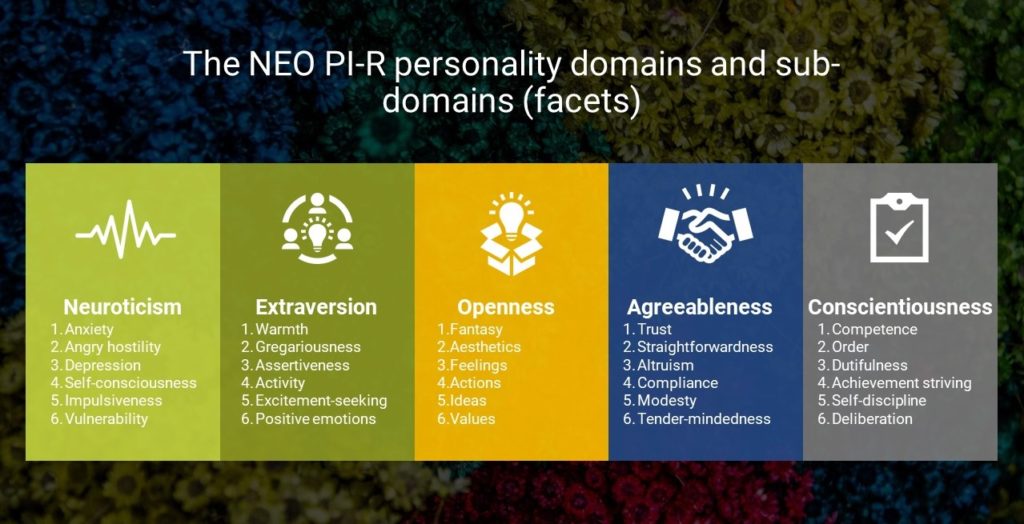Employee's Assessment Indicator - EAI
You Want Satisfied Performing Employees in your organization?
You Want Work Synergy in your Organization?
Are you looking for self-motivated employees?
Try ESP for all you need…
Welcome to “OCEAN”
Organizations utilize personality inventories such as the Five Factor Model of Personality for a range of purposes including selection and recruitment and employee management. Over the last twenty years, HRM scientists and practitioners have identified the Five Factor Model as a useful tool in predicting employee performance across a range of jobs and settings. The Five Factor Model also called Big Five can be utilized to increase organizational effectiveness.

The Five Factor Model of personality predicts job satisfaction
Workers who are more satisfied in their jobs are more likely to stay in the organization, tend to be better performers and are less absent from work. Accordingly, it is important to determine if the Five Factor Model is related to job satisfaction. Research has indicated that several of the five traits are related to job satisfaction with neuroticism showing a negative correlation with job satisfaction and conscientiousness, extraversion, and agreeableness positively related to job satisfaction (Judge, Heller & Mount, 2002).
How can the Five Factor Model of personality be measured?
There are a variety of valid personality measures that can be used to assess the Big Five. The most popular is the NEO Personality Inventory that has gone through various revisions (McCrae, Costa & Martin, 2005). There is a long and short version of the NEO with the long version consisting of 240 items and the shorter version consisting of only 60 items (The one use by ESP). The measure is suitable for use with people of all ages. One of the benefits of the use of the NEO Personality Inventory is that it can assess both broad and narrow personality traits. The Big Five model represents five major personality traits, which you can remember using the OCEAN acronym:
- Openness
- Conscientiousness
- Extraversion/Extroversion
- Agreeableness
- Neuroticism
The Five Factor Model of personality can help curb counter-productive behavior
Employees deviate from acceptable workplace behavior when they engage in actions that harm the well-being of the individual or the organization. These types of behaviors include, stealing, withholding job effort (organizational deviance) and hostile behavior towards coworkers (interpersonal deviance). Interpersonal deviance is negatively correlated with high levels of agreeableness whereas organizational deviance is negatively related with high levels of conscientiousness and positively correlated with neuroticism. These findings imply that individuals who are emotionally stable and conscientious are less like to engage in organizational deviant behavior (Colbert, Mount, Harter, Witt, & Barrick, 2004).

The Five Factor Model of personality helps determine effective leadership
Research has also shown linkages between the Five Factor Model and leader effectiveness. Research shows that extroverts are more likely to succeed in leadership positions. Extraversion was a valid predictor for management performance (Barrick & Mount, 1991) and Judge and Bono found that extroversion positively predicted charisma and inspirational motivation, a component of transformational leadership. Lim and Plohart (2004) also found a significant relationship between extraversion and leadership abilities.
There is also a link between agreeableness and leader effectiveness. Agreeable individuals are cheerful, adventurous, adaptable, friendly, likeable, generous, tolerant, and courteous (Barrick & Mount, 1991). Judge and Bono found agreeableness was a strong predictor of transformational leadership, accounting for 7% of the variance in transformational leadership.
The Five Factor Model of personality can help predict career success
There is also evidence that the Big Five Model is useful in predicting career success. In a study of 496 employees across a wide range of occupations and organizations, Seibert and Kramer (2001) found that extraversion was related to salary level, promotions, and career success. They also found that neuroticism was related negatively to career satisfaction (Seibert & Kramer, 2001).
In an interesting long-term study of the working lives of women, George and colleagues analyzed work over time from preliminary activities (in the twenties) to decreasing work involvement (after age 60), utilizing three of the Big Five personality traits as predictors of career outcomes (George, Helson & John, 2011). The three traits examined were extraversion (work as pursuit of rewards), openness (work as self-actualization) and conscientiousness (work as duty).
The researchers found that the socio-economic climate impacted the relationship between the personality traits and work lives. As expected, there was no significant relationship between the personality traits and work lives in the mid-60s, with young women being gender typed and family-oriented (George et al., 2011). However, as the climate changed, work outcomes were related to all three of the traits and predicted career status and satisfaction achieved, as well as continued work participation and financial security in late adulthood (George et al., 2011).


